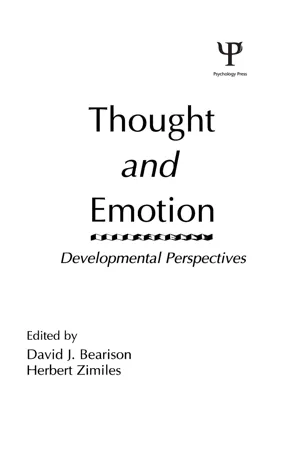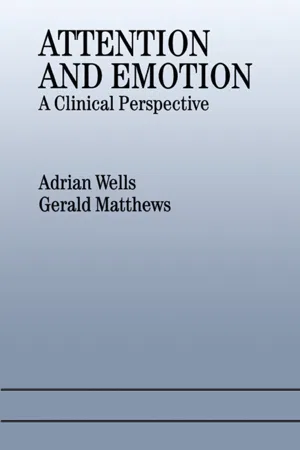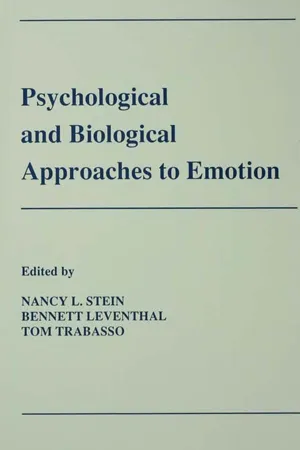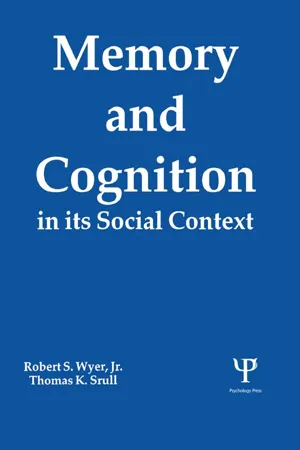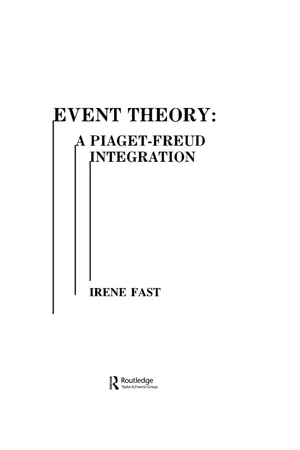Psychology
Cognitive Theory of Emotion
The Cognitive Theory of Emotion suggests that our emotions are influenced by our thoughts, perceptions, and interpretations of events. It emphasizes the role of cognitive processes in shaping emotional experiences, proposing that our appraisal of a situation determines our emotional response. This theory highlights the significance of mental processes in understanding and managing emotions.
Written by Perlego with AI-assistance
Related key terms
7 Key excerpts on "Cognitive Theory of Emotion"
- eBook - ePub
Thought and Emotion
Developmental Perspectives
- D. J. Bearison, H. Zimiles(Authors)
- 2014(Publication Date)
- Psychology Press(Publisher)
Yet, if confusion about what is to be meant by terms like cognition and emotion is to be avoided, some explicit characterization of metatheoretical commitments seems to be a necessity. We need, in other words, reasoning of the following sort: Given that this is the way the world (human and nonhuman, mental and physical) is organized and that this is the nature of the psychologist's task, then this is the general form that theoretical explanation ought to take. Within the context of this form of general theory, here is a way to make consistent sense of the terms cognition and emotion. Given that this is what we mean by cognition and emotion, here is a theoretical specification of the nature of cognitive and emotional psychological structures and processes, of the way in which these structures and processes might be related, and of the way in which developments in one might be reflected in the other.This is a large task. To provide a framework that makes consistent sense of questions about the relationship between emotion and cognition, we need a theory broad enough to give theoretical meaning to the terms cognition and emotion, if we are to make that theory reasonably clear and consistent, we need to characterize the metatheoretical principles on which it is based in a way that answers the seldom-asked question, "What kind of a theory is this?"It would be optimistic indeed to think that this could be adequately accomplished within the framework of a single chapter. Still, it is possible to indicate, in at least a preliminary way, some general ideas about the requirements for potentially adequate psychological theory that I have been developing over the past few years (Wozniak, 1975, 1981, 1983) and within that framework to discuss both the range of theoretical meanings that might accrue to terms like cognition and emotion and the sense that can and cannot (given the framework) be made of questions about the developing relationship between cognitive and emotional structures and processes. Following this, in order to indicate the potential value of this sort of analysis for the clarification of claims that theorists of emotion and cognition make, I will briefly and critically discuss one recently articulated and influential view of the development of the relation between emotion and cognition: the differential emotions perspective of Izard (1977, 1978, and chapter 3 - eBook - ePub
Attention and Emotion
A Clinical Perspective
- Gerald Matthews, Adrian Wells(Authors)
- 2016(Publication Date)
- Psychology Press(Publisher)
CHAPTER ONE Introduction: Cognitive Theory of Emotional DisordersClinical psychology has been revolutionised by an influx of ideas and techniques derived from cognitive psychology and by the central metaphor that the mind functions as a processor of information. The basic assumption of the clinical application of cognitive theory has been expressed most economically by Ellis (1962). He suggests that emotional disorder is associated with irrational beliefs, particularly about the self. Irrational beliefs lead to both unpleasant emotions and ineffective, maladaptive behaviour. This theory expresses several hypotheses which have become widely accepted by clinicians working within the cognitive approach. First, beliefs have a causal effect on emotion and well-being. This hypothesis differentiates the cognitive approach from behaviourism. Second, beliefs, as causal agents, are expressed in verbal, propositional form, and can be accessed consciously during therapy. This hypothesis distinguishes the cognitive approach from most psychodynamic approaches, in which “latent” beliefs are unconscious. Third, therapy should be directed towards changing beliefs through restructuring cognitions, as in Ellis’ (1962) rational emotive therapy, in which the patient is taught to recognise and modify irrational, harmful self-beliefs.The core assumptions of the cognitive approach just described are not in themselves sufficient to provide a workable model of emotional disorder. The most obvious difficulty is the resistance to change in irrational beliefs often encountered clinically. The person’s self-knowledge is not simply an internal “file” of disconnected beliefs which the therapist can erase and replace with more realistic propositions. People seem to construct and revise self-beliefs actively on the basis of some internal set of ground rules for interpreting the world. Emotionally disturbed patients may be characterised not so much by their specific beliefs as by the general frameworks they use to understand their environment and their place in it. In other words, clinicians must address the cognitive processes by which patients arrive at their maladaptive interpretation of the world. Another factor is the possibility of unconscious cognitive processing. Studies comparing introspective reports of processing with objective data have shown that people lack awareness of even some quite complex mental operations (Nisbett & Wilson, 1977). A patient’s self-reports will provide only an incomplete and possibly distorted picture of their actual cognitive functioning. Psychopathology may be influenced by “automatic” processes, which may be more difficult to influence than conscious beliefs. In addition, people may fill the gap in conscious awareness by making attributions - Nancy L. Stein, Bennett Leventhal, Thomas R. Trabasso(Authors)
- 2013(Publication Date)
- Psychology Press(Publisher)
Bower & Cohen, 1982 ). That simply acknowledges theoretical agnosticism; it does nothing to solve the problem.Emotion is not only anecdotally and phenomenally part of human thought and action; there is now a burgeoning body of evidence that emotional states interact in important ways with traditional “cognitive” functions. For example, Isen's work has shown that positive feelings determine the accessibility of mental contents in the process of decision making, serve as retrieval cues, and influence problem-solving strategies (e.g., Isen, Means, Patrick, & Nowicki, 1982 ). More generally, accessibility of mental contents is determined by the mood both at the time of original encounter and at the time of retrieval (Bower, 1981 ; Bower & Mayer, 1985 ).There are essentially two different views of emotional phenomena. One considers emotions to be discrete patterns of behavior, experience, and neural activity, usually consisting of some few (5 to 10) such patterns—the fundamental emotions such as fear, joy, and rage. I refer to this as the fundamentalist position (e.g., Izard, 1977 ; Plutchik, 1980 ; Tomkins, 1962 , 1963 ). Most of these theories are derived from Darwin (1872) , and basic emotions usually are seen as having developed as a function of human (mammalian) evolution, with other emotions being some combination of the fundamental ones. Given the wide variety of human emotion, this latter postulate engenders complex analyses of and recipes for emotion—something like a cordon bleu school of emotion.The other approach is cognitive and constructivist, which considers emotional experience (and behavior) to be the result of cognitive analyses and physiological (autonomic nervous system) response (e.g., Averill, 1980 ; Lazarus, Kanner & Folkman, 1980 ; Mandler, 1984 ). The constructivist approach has as its founding father William James (e.g., 1884- eBook - ePub
- Catherine Pelachaud(Author)
- 2013(Publication Date)
- Wiley-ISTE(Publisher)
These theories have also been highly useful for understanding intra- and interpersonal differences, notably cultural and social, in the triggering and differentiation of emotions. 1.5.3. Criticisms of appraisal theories of emotion The main criticism of these theories is their potentially excessive cognitivism. As such, while researchers opposed to this approach accept that appraisal theories explain specific types of emotional reaction, they deny the necessity of this process and propose that in a number of cases emotions are produced by non-cognitive factors [BER 93, LED 93, OHM 78, ZAJ 84]. A key question concerning the “emotion/cognition” debate lies in the definition of the term “cognition” (see the glossary in section 1.7). If we accept that appraisal can occur rapidly on several cognitive levels, including automatic and unconscious processes, then the criticism of excessive cognitivism no longer holds up (see [LEV 87] for their proposition of levels of processing in the appraisal process [MOO 09, MOO 10, ROB 09]). Another criticism of these theories concerns emotional disorders. For example, for a sufferer of arachnophobia, acquiring the explicit knowledge that a spider is harmless does not stop them from being scared [GRI 04]. The notion of levels of processing therefore seems equally important for responding to this criticism. However, it should be noted that this “multi-level” approach to the appraisal process has also been criticized because the levels proposed could be seen as being too diverse to cover the general concept of appraisal [GRI 04] - eBook - ePub
Women's Anger
Clinical and Developmental Perspectives
- Deborah Cox, Sally Stabb, Karin Bruckner(Authors)
- 2016(Publication Date)
- Routledge(Publisher)
Lewis’s (1993) position, Dodge argues that (a) all cognition is emotional, in the sense that all processing occurs with some level of arousal and energy; (b) the goal directing aspect of emotion drives attentional processes; and (c) our phenomenological experience of emotion can alter interpretation and vice-versa. In other words, as we reflect upon what we want to change or obtain, we attend to those things affectively and cognitively. We both think and feel about them simultaneously. Thus, Dodge sees cognition and emotion as integrated with each other but gives prominence to cognitive information processing as the basis for emotion.Stein, Trabasso, and Liwag (1993) present a cognitive appraisal model of emotion that is knowledge-based and situated, by which the authors mean that it explores the content of emotions, as well as conditions that elicit emotion, and plans or actions carried out in response to emotional reactions. Stein and colleagues assume that people have the ability to act intentionally and are goal-directed. People assess and monitor the status of their goals, particularly those with a high degree of salience or meaning to them. In this model, we have an emotion if our preestablished schemas about those goals do not match new information we receive. This mismatch triggers both a cognitive evaluation process and ANS arousal, which together constitute emotion.Taking a cross-cultural perspective on appraisal Ellsworth (1994) proposes that cultural differences in reported emotion can be explained by variation in how people appraise situations across cultures. She identifies a series of basic appraisal dimensions: attention/novelty (a change in the environment), valence/pleasantness (is the change positive or negative?), agency/control (can I do anything about it?), and norm/self compatiblity (have I lived up to or fallen short of some standard of my community or myself?). Different cultures encourage different interpretations of social situations along these dimensions, which most likely result in different emotions. This idea echoes in the work of Frijda and Mesquita (1994) - eBook - ePub
- Robert S. Wyer, Jr., Thomas K. Srull(Authors)
- 2014(Publication Date)
- Psychology Press(Publisher)
The two factors are obviously related. One’s affective reaction to a stimulus is basically an attribute of oneself. Moreover, the affect or emotion that one experiences may be both a determinant and an effect of one’s self-perceptions and the thoughts that one has about them. However, several theoretical and empirical issues are unique to each factor. In this chapter, we consider both the cognitive determinants and the cognitive consequences of people’s emotional experiences. Because our discussion cuts across almost all of the types of processing we have considered in previous chapters, it incidentally provides an integration of many of the issues we have addressed earlier.The Cognitive Representation of Affect and EmotionSingle stimuli or configurations of stimuli that we encounter in daily life often elicit configurations of subjective, physiological reactions. These reactions may either be innate, unconditioned responses to stimuli or may have become conditioned to stimuli through learning. Although we are typically unable to isolate the particular reactions that make up any given cluster, we are conscious of their occurrence and experience them as either pleasant or unpleasant. Moreover, we distinguish qualitatively between different clusters of pleasant (or unpleasant) reactions, and consequently come to assign them different verbal labels. This is presumably also a result of social learning. A mother who hears her child cry or observes other manifestations of an internal state that she personally labels as “sad” may tell the child “Don’t be sad.” This may lead associations to be formed between the label “sad,” the cluster of internal reactions the child experiences, and overt behaviors (e.g., crying) that the child is aware of manifesting. The resulting configuration of associations among subjective physiological reactions, behavioral manifestations, and verbal labels comes to function as a concept that is stored in memory, where it can be retrieved and used to process information and knowledge in much the same way as other concepts. - eBook - ePub
Event Theory
A Piaget-freud Integration
- Irene Fast, Robert E. Erard, Carol J. Fitzpatrick, Anne E. Thompson, Linda Young(Authors)
- 2013(Publication Date)
- Routledge(Publisher)
The remainder of the chapter sets forth a cognitive, intensional, and constructivist model of affect development integrating views from psychoanalytic, Piagetian, and contemporary cognitive developmental psychology. Although it is commonplace to think of affects as the most “subjective” of human phenomena, this chapter takes the view that the ability to attribute affects to the self and to conceptualize affects as “internal” psychological states of the self is a central and difficult developmental accomplishment, one that is achieved only with the decline of infantile narcissism and with the successive “decentrations” throughout development that gradually transform the human child from egocentricity to cognitive objectivity. The corollary of this objectivity is the subjectivity of affect.A Cognitive-Intensional-Constructivist View of EmotionBefore I go on to explain the terms “cognitive,” “intensional,” and “constructivist,” a few caveats are in order. First, this discussion is meant to be a limited undertaking, that of providing a description of some necessary features of emotion, not a comprehensive theory or a definition of emotion. Second, these features are meant to apply to the conceptualization of emotion, not to an introspective or phenomenological analysis of emotional states. In other words, to say that emotions have intrinsic cognitive components does not entail that we are always aware of these cognitive components in the emotions that we experience. Third, this conceptualization is meant to apply to adult, “mature,” standard cases of emotion. I am not claiming that in very young children emotions are “intensional,” or that their emotions are “cognitive” in the same sense as those of a mature adult. To explain how emotions develop into their mature form is a task of this chapter.In saying that emotions are intensional (following Brentano, 1973/1874), I want to emphasize this aspect of emotion, namely, that emotions are “of” something, that emotions are “directed” to objects. If one is fearful, one is fearful of something (though one may not be able to articulate just what that is); if one loves, one loves someone or something; if one is angry, one is angry at someone or something. Leeper (1970) and Averill (1980) are two psychologists who have held this view explicitly, although implicitly it seems to underly much recent research in the cognitive developmental psychology of the emotions. In saying that emotions are cognitive,3 I am suggesting that emotion has cognition as an intrinsic part, that emotions and their cognitions are not conceptually separable. (Certainly we may be aware of an emotion without awareness of its cognitive aspects. As mentioned above, this paper is intended to be a conceptual analysis of emotion, not an introspective one.) I see these two aspects as being related—it is via their cognitive aspects that we can explain the “directedness” of emotion. In saying that this account is constructivist
Learn about this page
Index pages curate the most relevant extracts from our library of academic textbooks. They’ve been created using an in-house natural language model (NLM), each adding context and meaning to key research topics.
